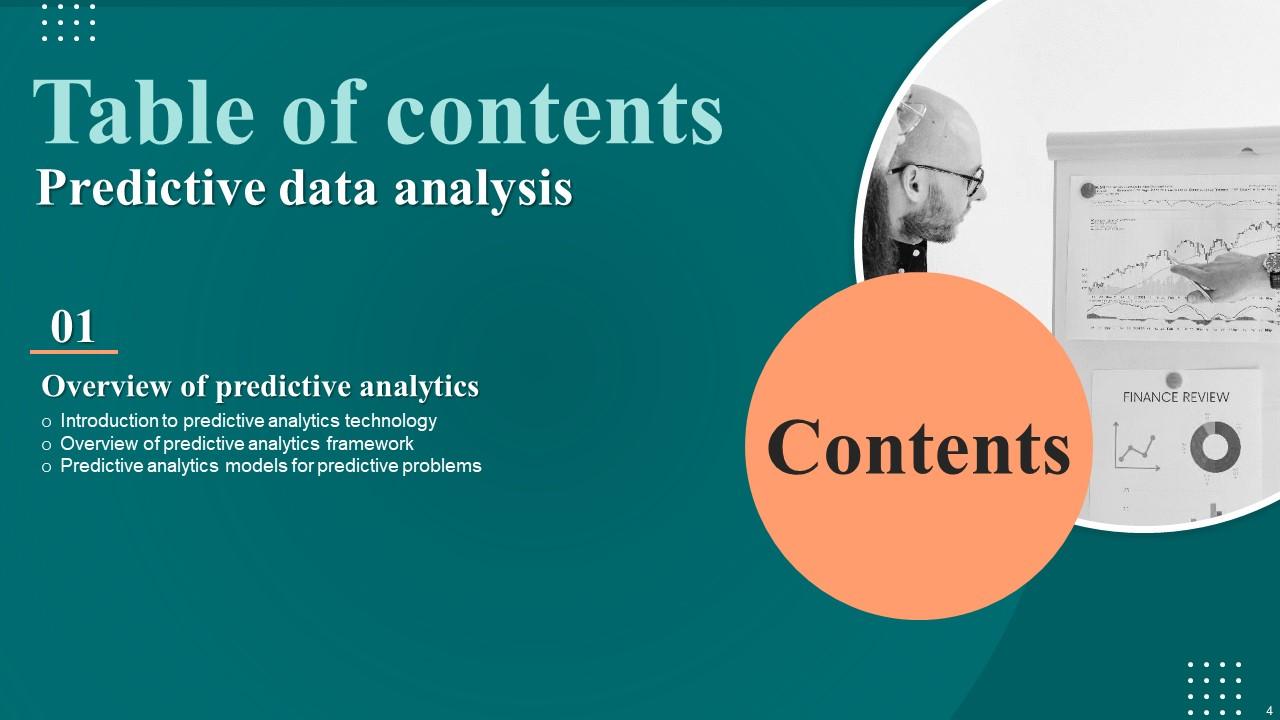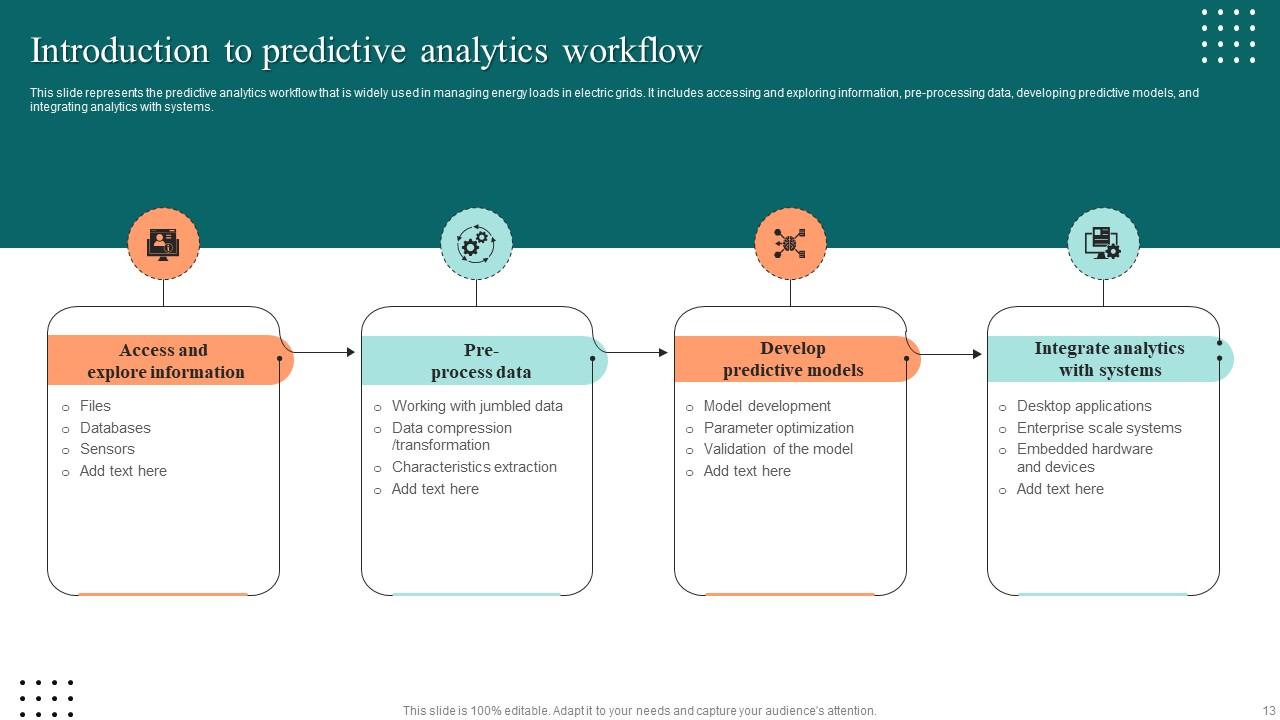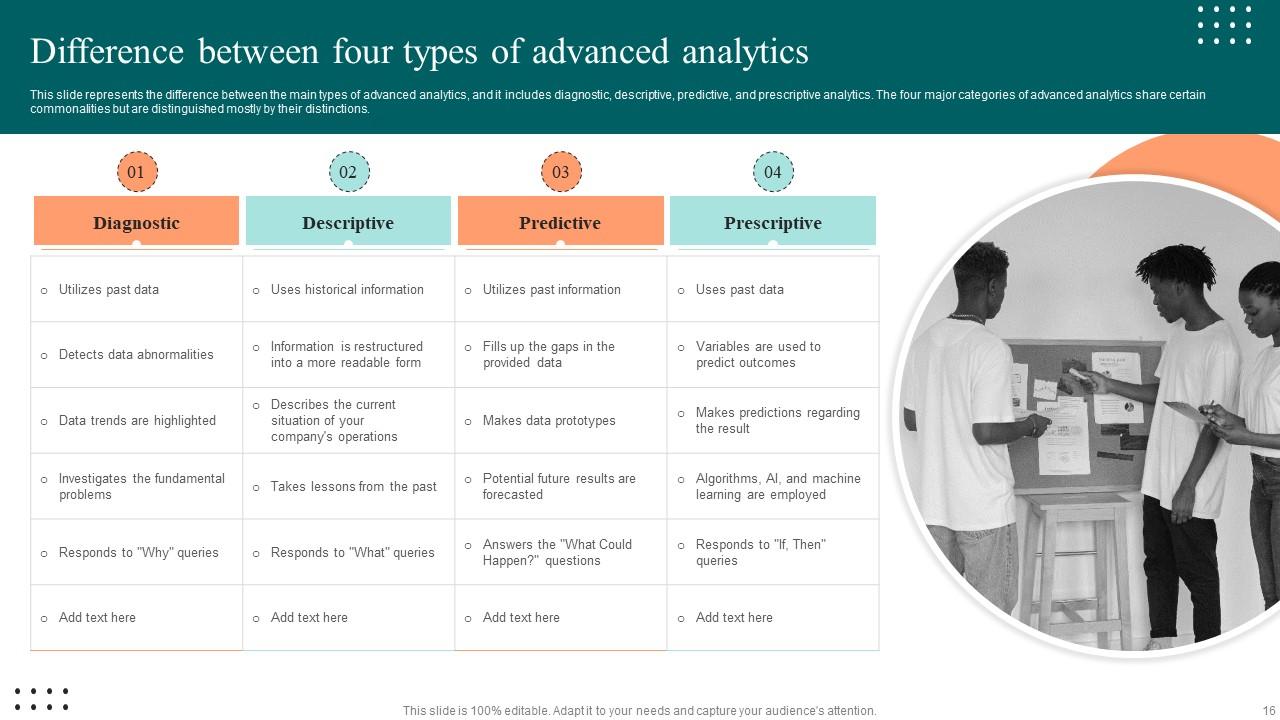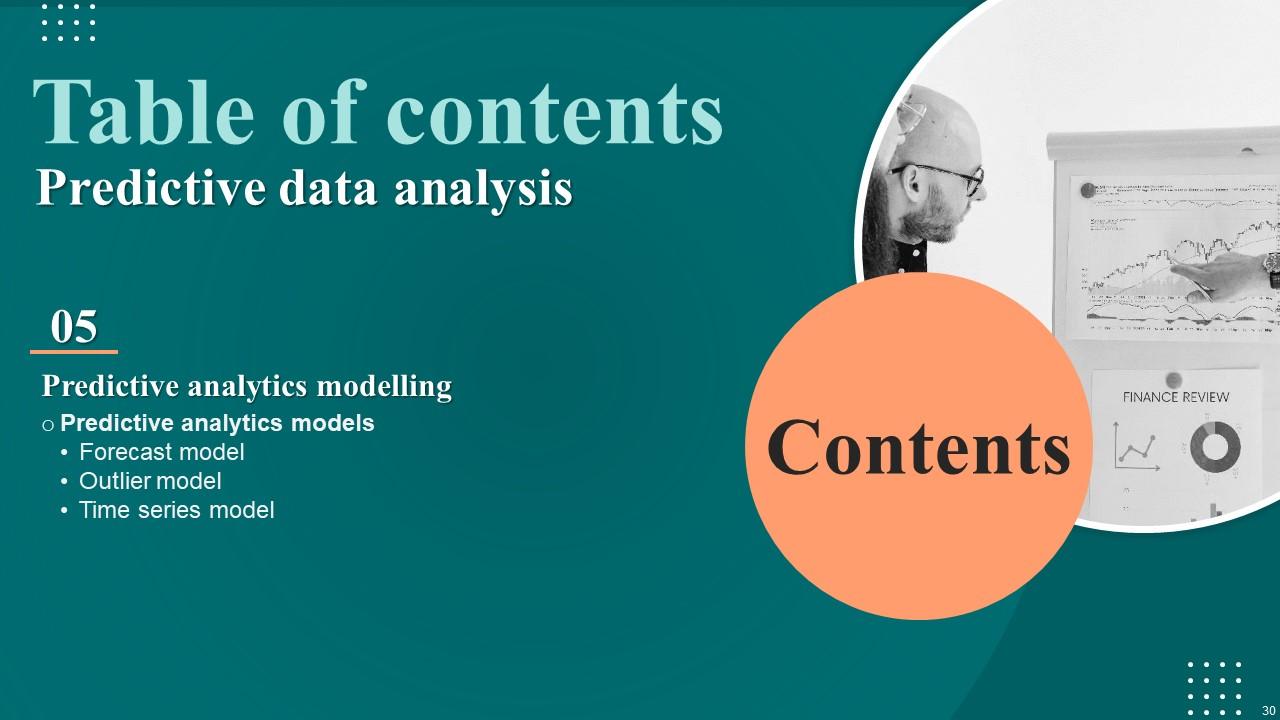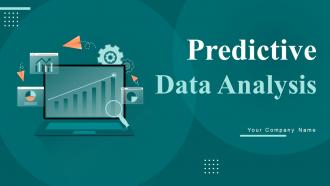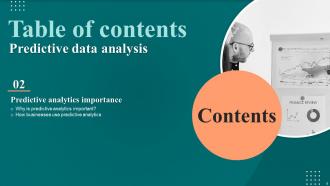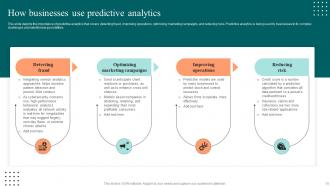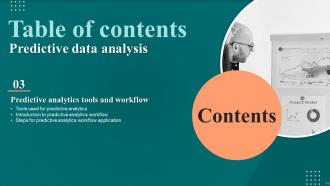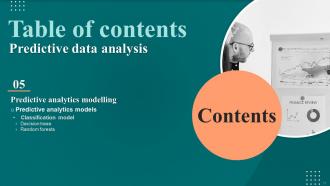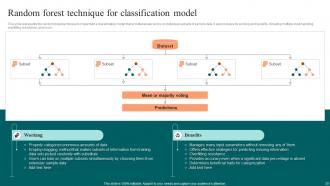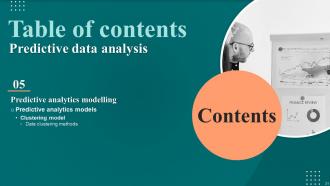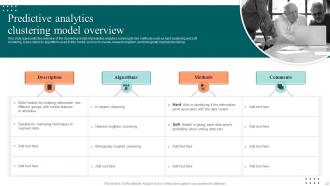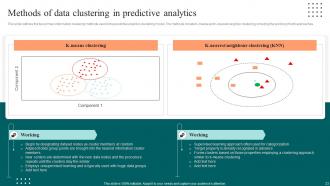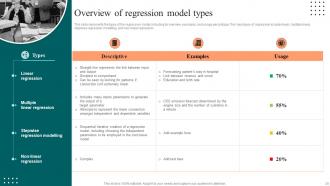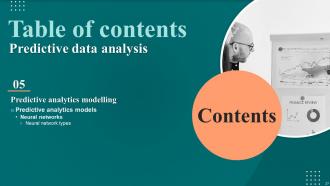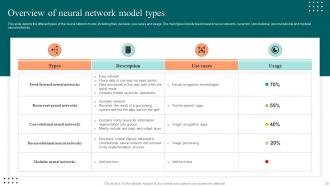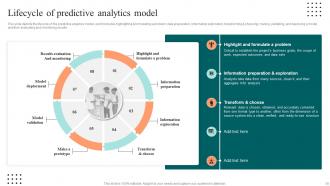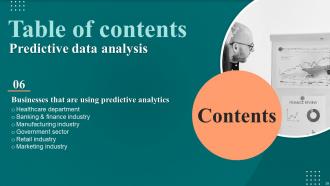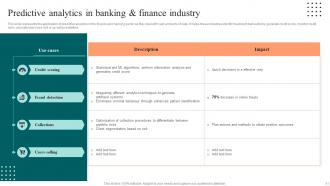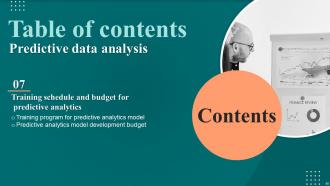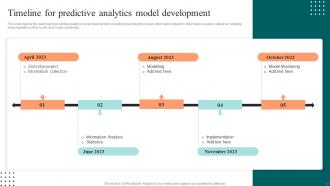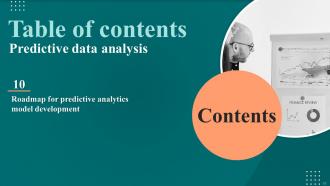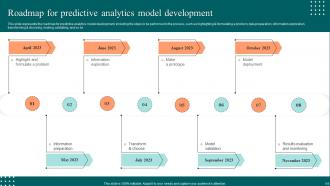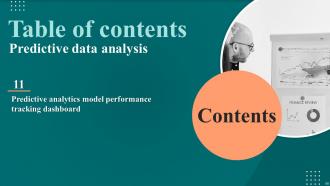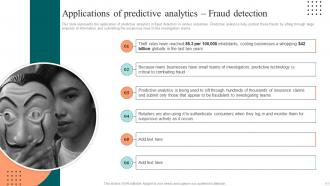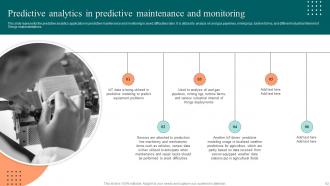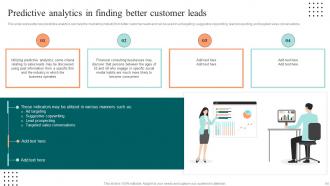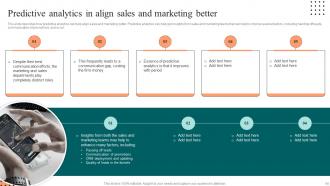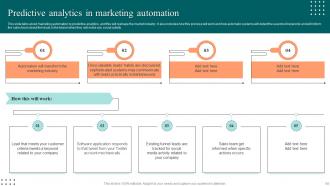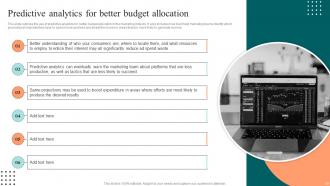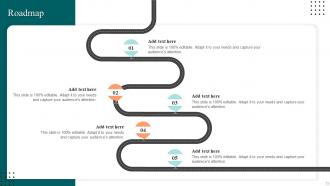Predictive Data Analysis Powerpoint Presentation Slides
Predictive analytics is applicable and valuable to nearly every industry. Check out our efficiently designed Predictive Data Analysis template. It gives a brief idea about predictive analytics, which uses statistical techniques, machine learning algorithms, and other tools to analyze historical data. It also makes predictions about future events or outcomes. In our Predictive Analytics deck, we have covered the introduction to predictive analytics, its framework, and different models. It shows the importance of predictive analytics with its usage. In addition, our Estimation Model PPT exhibits the different predictive analytics tools and their workflow. Further, it covers the difference between the four types of advanced analytics. Our Forecast Model PPT reveals multiple predictive analytics models like classification models, clustering models, etc. Furthermore, it caters to the prominent business sectors that are already using predictive analytics in their daily operations. These include the healthcare department, banking, finance, and many more. Moreover, this Prospective Analysis module comprises a training program and a budget to develop a predictive analytics model. Lastly, it showcases a checklist, a timeline, and a roadmap for predictive analytics model deployment with a performance tracking dashboard. Get access now.
- Google Slides is a new FREE Presentation software from Google.
- All our content is 100% compatible with Google Slides.
- Just download our designs, and upload them to Google Slides and they will work automatically.
- Amaze your audience with SlideTeam and Google Slides.
-
Want Changes to This PPT Slide? Check out our Presentation Design Services
- WideScreen Aspect ratio is becoming a very popular format. When you download this product, the downloaded ZIP will contain this product in both standard and widescreen format.
-

- Some older products that we have may only be in standard format, but they can easily be converted to widescreen.
- To do this, please open the SlideTeam product in Powerpoint, and go to
- Design ( On the top bar) -> Page Setup -> and select "On-screen Show (16:9)” in the drop down for "Slides Sized for".
- The slide or theme will change to widescreen, and all graphics will adjust automatically. You can similarly convert our content to any other desired screen aspect ratio.
Compatible With Google Slides

Get This In WideScreen
You must be logged in to download this presentation.
PowerPoint presentation slides
This complete deck covers various topics and highlights important concepts. It has PPT slides which cater to your business needs. This complete deck presentation emphasizes Predictive Data Analysis Powerpoint Presentation Slides and has templates with professional background images and relevant content. This deck consists of total of seventy four slides. Our designers have created customizable templates, keeping your convenience in mind. You can edit the color, text and font size with ease. Not just this, you can also add or delete the content if needed. Get access to this fully editable complete presentation by clicking the download button below.
Content of this Powerpoint Presentation
Slide 1: This slide introduces Predictive Data Analysis.
Slide 2: This is an Agenda slide. State your agendas here.
Slide 3: This slide shows Table of Content for the presentation.
Slide 4: This slide again continues with Table of content with overview of Predictive data analysis.
Slide 5: This slide represents the predictive analytics introduction.
Slide 6: This slide outlines the overview of the predictive analytics framework and its components.
Slide 7: This slide depicts the overview of predictive analytics models, including the predictive problems they solve.
Slide 8: This slide renders another Table of contents with Predictive data analysis.
Slide 9: This slide demonstrates the importance of predictive analytics in different industries.
Slide 10: This slide illustrates the importance of predictive analytics and how businesses use it.
Slide 11: This slide also presents Table of contents with difference between four types of advanced analytics.
Slide 12: This slide represents the difference between the main types of advanced analytics.
Slide 13: This slide again showcases Table of content for Predictive analytics tools and workflow.
Slide 14: This slide depicts the tools used for predictive analytics to perform operations in predictive models.
Slide 15: This slide displays the predictive analytics workflow that is widely used in managing energy loads in electric grids.
Slide 16: This slide illustrates the steps for predictive analytics workflow application in industries.
Slide 17: This is another slide continuing Table of content with Predictive analytics modelling.
Slide 18: This slide describes the overview of the classification model used in predictive analytics.
Slide 19: This slide depicts the decision tree model of predictive analytics that are beneficial for quick decision-making.
Slide 20: This slide presents the random forest technique to implement a classification model.
Slide 21: This slide also displays Table of contents for Predictive analytics modelling.
Slide 22: This slide represents the overview of the clustering model of predictive analytics covering its two methods.
Slide 23: This slide outlines the two primary information clustering methods used in the predictive analytics clustering model.
Slide 24: This is another slide depicting Table of content for Predictive analytics modelling.
Slide 25: This slide presents the regression model of predictive analytics that is most commonly used in statistical analysis.
Slide 26: This slide represents the types of the regression model, including its overview.
Slide 27: This slide continues Table of content for Predictive analytics modelling.
Slide 28: This slide depicts the neural networks model of predictive analytics that behave in the same manner as a human brain does.
Slide 29: This slide displays the different types of the neural network model types.
Slide 30: This is another slide for table of content for Predictive analytics modelling.
Slide 31: This slide provides the introduction of the forecast model used for predictive analytics to make the metric value predictions.
Slide 32: This slide contains the outliers model used for predictive analytics.
Slide 33: This slide illustrates the time series model of predictive analytics that makes future outcome predictions.
Slide 34: This slide again shows Table of content for Predictive analytics modelling.
Slide 35: This slide discusses the steps required to create predictive algorithm models for business processes.
Slide 36: This slide depicts the lifecycle of the predictive analytics model.
Slide 37: This slide exhibits the working of predictive analytics models that operates iteratively.
Slide 38: This slide represents the development process of predictive analytics that uses recent and past information.
Slide 39: This slide showcases table of content for Businesses that are using predictive analytics.
Slide 40: This slide outlines the application of predictive analytics in the healthcare department for forecasting the probability of patients.
Slide 41: This slide represents the application of predictive analytics in the finance and banking sector.
Slide 42: This slide renders about using predictive analytics in manufacturing forecasting for optimal use of resources.
Slide 43: This slide displays the usage of predictive analytics technology in the government sector to improve cybersecurity.
Slide 44: This slide presents the application of predictive analytics technology in the retail industry.
Slide 45: This slide outlines the use of predictive analytics in the marketing industry.
Slide 46: This slide illustrates Table of content for Training schedule and budget for predictive analytics.
Slide 47: This slide demonstrates the training program for the predictive analytics model.
Slide 48: This slide describes the budget for developing predictive analytics model by covering details of project cost.
Slide 49: This slide depicts Table of content for Checklist for predictive analytics model deployment.
Slide 50: This slide represents the checklist for predictive analytics deployment that is necessary for organizations.
Slide 51: This slide shows Table of content for Timeline for predictive analytics model development.
Slide 52: This slide depicts the roadmap for predictive analytics model development, including describing the project.
Slide 53: This slide displays Table of content for Roadmap for predictive analytics model development.
Slide 54: This slide represents the roadmap for predictive analytics model development, including the steps to be performed in the process.
Slide 55: This slide showcases Table of content for Predictive analytics model performance tracking dashboard.
Slide 56: This slide presents the predictive analytics model performance tracking dashboard,covering all the details.
Slide 57: This slide shows all the icons included in the presentation.
Slide 58: This slide is titled as Additional Slides for moving forward.
Slide 59: This slide describes the usage of predictive analytics in banking and other financial institutions for credit purposes.
Slide 60: This slide exhibits the application of predictive analytics in underwriting by insurance companies.
Slide 61: This slide depicts the application of predictive analytics in fraud detection in various industries.
Slide 62: This slide renders the predictive analytics application in predictive maintenance and monitoring to avoid difficulties later.
Slide 63: This slide illustrates the comparison between predictive analytics and machine learning based on technology used and built on.
Slide 64: This slide displays how predictive analytics can help the marketing industry find better customer leads.
Slide 65: This slide depicts how predictive analytics help identifies prospects faster in the marketing industry.
Slide 66: This slide describes how predictive analytics can help align sales and marketing better.
Slide 67: This slide outlines how predictive analytics can help understand existing customers' needs.
Slide 68: This slide exhibits about marketing automation by predictive analytics, and this will reshape the market industry.
Slide 69: This slide renders the use of predictive analytics for better budget allocation in the marketing industry.
Slide 70: This is About Us slide to show company specifications etc.
Slide 71: This is an Idea Generation slide to state a new idea or highlight information, specifications etc.
Slide 72: This is Our Target slide. State your targets here.
Slide 73: This slide presents Roadmap with additional textboxes.
Slide 74: This is a Thank You slide with address, contact numbers and email address.
Predictive Data Analysis Powerpoint Presentation Slides with all 79 slides:
Use our Predictive Data Analysis Powerpoint Presentation Slides to effectively help you save your valuable time. They are readymade to fit into any presentation structure.
FAQs
The main types of predictive analytics models are classification models, clustering models, regression models, neural network models, forecast models, and time series models. Each model serves a specific purpose in analyzing and predicting data.
The clustering model in predictive analytics involves grouping similar data points together based on certain characteristics, allowing analysts to discover patterns and insights within the data.
The lifecycle of a predictive analytics model includes data collection, data preprocessing, model building, model evaluation, deployment, and continuous monitoring. This ensures that the predictive model remains accurate and effective over time.
Predictive analytics is applied in the healthcare department for forecasting the probability of patients. This helps in predicting disease outcomes, identifying high-risk patients, and optimizing treatment plans for better patient care.
Predictive analytics benefits the finance and banking sector in various areas, such as fraud detection, credit scoring, risk assessment, customer segmentation, and investment forecasting. It enables informed decision-making and helps mitigate potential risks.
-
Nice and innovative design.
-
I'm happy to discover your PowerPoint presentations and templates. They met my expectations precisely. Very innovative!






